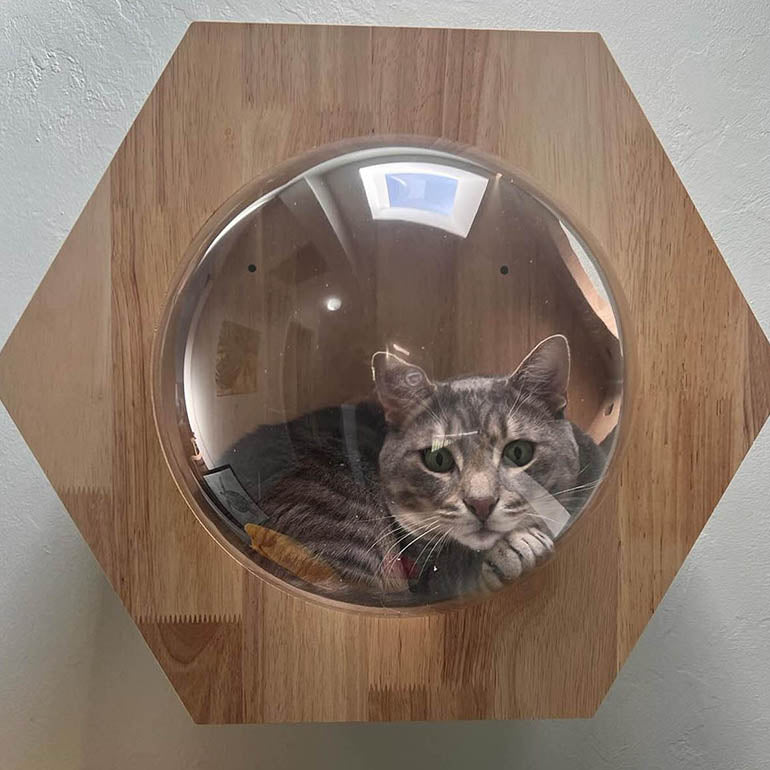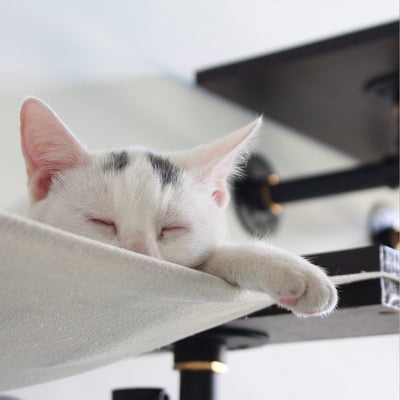Keeping your cat’s weight in check
Just like us, cats will put on weight if they eat too much and don’t exercise enough. Obesity is one of the most common health problems seen by our vets. It can cause health problems such as:
- Diabetes
- Heart disease
- Arthritis.
Pets with conditions like these often die younger which is heart-breaking for their owners.
A Healthy Body Shape for Your Cat
Looking at your cat’s shape is the best way of keeping an eye on their weight. That’s because the ideal weight varies for every type and breed - but the ideal shape is the same for every cat.
Check your cat’s weight every couple of weeks, starting when they’re a kitten. You’ll quickly learn what’s normal for your cat. All you have to do is look and feel:
- Look at your cat from the side and from above. They should have a smooth, tucked-in waist.
- Feel under your cat’s tummy. It should go in, not bulge out.
- Feel along your cat’s side and back. You should be able to feel your cat’s ribs, spine and hipbones quite easily but they shouldn’t stick out.
- Feel the base of your cat’s tail. There shouldn’t be any build-up of fat where the tail meets your cat’s back.
Your vet or vet nurse can show you how to check your cat’s shape.
SEVERELY UNDERWEIGHT
A severely underweight cat has no layer of fat covering its ribs. If your cat’s in this grade and short-haired, you’ll be able to see its ribs clearly. It will have no belly fat and a high belly line. If you look at your cat from above, its waist will bulge out significantly. Tips on how to help a severely underweight cat gain weight.
UNDERWEIGHT
An underweight cat has a minimal layer of fat covering its ribs and you can clearly feel the ribs if you press lightly. If your cat’s in the grade and short-haired, you might be just about able to see its ribs. It’ll have minimal belly fat and a tight belly line. If you look at the cat from above, its waist will bulge out. Tips on how to help an underweight cat gain weight.
IDEAL WEIGHT
A cat that’s of an ideal weight or normal weight has a thin layer of fat over its ribs, and you can feel its ribs when you press lightly. If your cat’s in this grade and short-haired, you shouldn’t be able to see its ribs. A cat in this grade will have a little belly fat and a belly line that’s slightly raised. If you look at the cat from above, it has a clear waist.
OVERWEIGHT CAT
An overweight cat has a moderate layer of fat over the ribs, and it’s difficult to feel the ribs at light pressure. It has moderate abdominal fat and a belly line that’s only minimally raised or even bulges. If you look at the cat from above, it has minimal or no waist. Tips on how to help an overweight cat lose weight.
SEVERELY OVERWEIGHT
A severely overweight cat has a thick layer of fat over its ribs, and it’s not possible to feel the ribs. It has a large amount of belly fat, and if you look at the cat from above, it has no waist and a rounded silhouette. Tips on how to help a severely overweight cat lose weight.
HOW DO I HELP MY CAT GAIN WEIGHT?
A cat that’s below its ideal weight (that is, is too thin) needs to increase its energy intake to gain weight. It needs to eat more and possibly a more energy-rich food. If you suspect your cat might be underweight due to illness, you should contact your vet.
Following the recommendations on the food’s packaging is a good way to ensure your cat receives enough food every day. Just be careful not to give them too much food. Oversized portions can overload your cat’s sensitive digestive system and actually have the opposite to desired effect, so it’s important to proceed cautiously.
If larger food portions aren’t an option, you can switch to a more energy-dense food. That way, you can give normal-sized portions that the cat’s stomach can handle, but still ensure your cat has the right energy intake.
HOW DO I HELP MY CAT LOSE WEIGHT?
An overweight or obese cat needs less food and possibly a food with a lower energy content to get down to its ideal weight. Losing as little as half a kilo can make a big difference to its health, wellbeing and quality of life. If you cat ranks as severely overweight, you should ask a vet for a specially adapted diet plan. If a very overweight cat loses weight too quickly, it can lead to life-threatening fatty liver.
The most common reason a cat becomes overweight is that it simply eats too much. Always follow the recommendations on the food’s packaging when feeding your cat. They’re the best tool for ensuring you’re giving the right amount of food. If your cat receives other food, such as leftovers or treats, you must also include this in their total daily allowance. Giving a cat leftovers is generally not recommended, as it can lead to deficiencies or excesses of nutrients.
Another thing you can do if your cat’s overweight is switch to a cat food with a lower energy density. It’s worth remembering that neutered cats have a slower metabolism than non-neutered cats, so they often need food that’s a little lower in calories.


